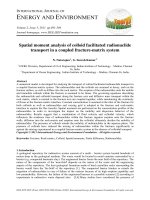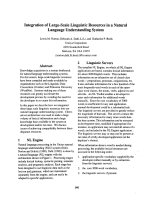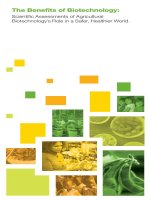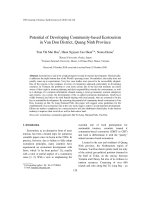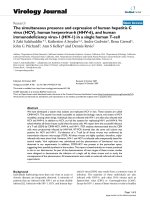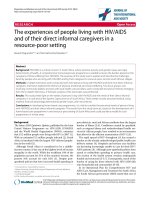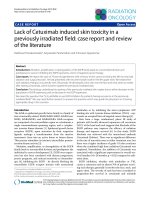The interface between the lived experience of women practicing abortion and attitude of the community towards abortion in a sociocultural context the case of woldia town, north wollo zone, amhara national regional state
Bạn đang xem bản rút gọn của tài liệu. Xem và tải ngay bản đầy đủ của tài liệu tại đây (1.23 MB, 160 trang )
ADDIS ABABA UNIVERSITY
COLLEGE OF SOCIAL SCIENCES
DEPARTMENT OF SOCIOLOGY
THE INTERFACE BETWEEN THE LIVED EXPERIENCE OF WOMEN PRACTICING
ABORTION AND ATTITUDE OF THE COMMUNITY TOWARDS ABORTION IN A
SOCIOCULTURAL CONTEXT: THE CASE OF WOLDIA TOWN, NORTH WOLLO
ZONE, AMHARA NATIONAL REGIONAL STATE
BY
ANTEHUNEGN BIRHANU
June 2017
ADDIS ABABA, ETHIOPIOA
1
THE INTERFACE BETWEEN THE LIVED EXPERIENCE OF WOMEN PRACTICING
ABORTION AND ATTITUDE OF THE COMMUNITY TOWARDS ABORTION IN A
SOCIOCULTURAL CONTEXT: THE CASE OF WOLDIA TOWN, NORTH WOLLO
ZONE, AMHARA NATIONAL REGIONAL STATE
A Thesis Submitted to the School of Graduate Studies of Addis Ababa
University in Partial Fulfillment of the Requirements for the Degree of Master
of Arts in Sociology
BY:
Antehunegn Birhanu
Advisor: Getnet Tadele (Prof.)
June, 2017
Addis Ababa, Ethiopia
2
Declaration
I hereby declare that this thesis is my original work and has neither been presented
in any other University nor was published before and that all sources of material
used for the thesis have been duly acknowledged.
Antehunegn Birhanu Bishaw
Signature-----------------------Addis Ababa University
June, 2017
3
Addis Ababa University
School of Graduate Studies
Department of Sociology
This is to certify that the thesis prepared by Antehunegn Birhanu entitled: The Interface between
the lived experience of Women Practicing Abortion and Attitude of the Community towards
Abortion in a Sociocultural Context: The Case of Woldia Town, North Wollo Zone, Amhara
National Regional State and submitted in partial fulfillment of the requirements of the Degree of
Master of Arts in Sociology compiles with the regulations of the University and meets the
accepted standards with respect to originality and quality.
Approved By Boards of Examiners and Advisor
Examiner (Internal) _____________________________Signature __________Date_________
Examiner (External)______________________________Signature__________Date________
Advisor _______________________________________Signature__________Date_________
4
Acknowledgements
First of all, I would like to thank the Almighty God for helping me to pass all difficult times of
my life and making possible the successful completion of my study regardless of the obstacles I
encountered in my ways.
I would like to express my heartfelt thanks, deepest gratitude and sincere appreciation to my
Advisor, prof. Getnet Tadele for his scholarly and constructive comments and suggestions to
accomplish this thesis work from the beginning to the end. It is unconceivable without his
constructive comments. Really, I learned a lot about research from the insightful comments and
critics he made available and experiences he shared.
Moreover, I would like to thank Woldia Town FGAE staff members, kebele officials and health
extension workers. Above all, health extension workers I have no words to thank their priceless
contribution to accomplish my thesis work. And also I did not forget the contribution of my staff
particularly Chanyalew, Balew and Ermiyas and Tewodros at Woldia University for their moral
support and data collection activities.
My heartfelt thank is also to my field assistants, particularly Tewodros Asefa, interviewees, key
informants, respondents and participants of group discussions of this study for allowing me to
access all the necessary data.
I am also indebted to my friends who were beside me. A special thanks to Genetu Desalew,
Mathewos Abebe, Molla Yismaw, Menberu Bekabill, Kelemu Fenta, Dereje Wondie, Habtamu
Nebere, Alelign Ewnetu, Dagnachew Adefris, Abduselam.M, Ambaye Tilahun and others who
were supporting me.
My deepest gratitude is also to my family members especially to my mother Hibsie Asress. I
have no words to express her sacrifice for my success. Long live Mam!
Last but not least, I would like to thank Addis Ababa University for providing the financial
assistance needed for the study.
i
Table of contents
Contents
page
Acknowledgements .......................................................................................................................... i
Table of contents ............................................................................................................................. ii
List of Tables ................................................................................................................................. vi
List of Figures ............................................................................................................................... vii
Acronyms ..................................................................................................................................... viii
Abstract .......................................................................................................................................... ix
CHAPTER ONE: INTRODUCTION ............................................................................................. 1
1.1
Background of the Study ..................................................................................................... 1
1.2
Statement of the Problem ..................................................................................................... 3
1.3
Objectives of the Study ........................................................................................................ 7
1.3.1
General Objective of the Study ................................................................................. 7
1.3.2
Specific Objectives of the Study ............................................................................... 7
1.4
Hypothesis............................................................................................................................ 7
1.5
Significance of the Study ..................................................................................................... 8
1.6
Delimitation of the Study ..................................................................................................... 9
1.7
Conceptualization Concepts................................................................................................. 9
1.7.1
1.8
Conceptualization of Terms .................................................................................... 10
Organization of the Thesis ................................................................................................. 11
CHAPTER TWO: REVIEW OF RELATED LITERATURE...................................................... 12
2.1
General Overview of the Concept of Abortion and Practice ............................................. 12
2.2
Incidence and Practice of Abortion in Africa .................................................................... 13
2.2.1
2.3
Abortion Incidence and Practice in Ethiopia .......................................................... 15
Socio-cultural Discourses on Abortion .............................................................................. 15
2.3.1
The Social Context of Abortion .............................................................................. 15
2.3.1.1 Religious Views on Abortion.................................................................................. 16
2.3.1.2 Moral Discourses on Abortion ................................................................................ 17
2.3.1.3 Legal Discourse on Abortion .................................................................................. 19
2.3.2
Medical Discourses and Health Care Services on Abortion ................................... 24
ii
2.3.2.1 Medical Ethics and Acceptability of Medical Abortion ......................................... 24
2.3.2.2 Reproductive Health Policies on Abortion ................................................................ 25
2.3.2.3 Health Risks of Induced abortion ........................................................................... 26
2.4
Gender Roles and Abortion ............................................................................................... 27
2.5
Abortion Stigma and Social Support ................................................................................. 27
2.6
Abortion and Public Attitudes ........................................................................................... 29
2.7
The Lived Experience of Women Practicing Abortion ..................................................... 32
2.8
2.7.2
Contextual and Personal factors on Women‟s Abortion Experience...................... 32
2.7.3
The Emotional Impact of Abortion on Women ...................................................... 34
2.7.4
Resilience Mechanism of Women Practicing Abortion.......................................... 36
A Guiding Theoretical Framework of the Study ............................................................... 37
2.8.2
Structuration Theory ............................................................................................... 37
2.8.3
The Relevance of Structuration Theory to This Study ........................................... 42
CHAPTER THREE: RESEARCH METHODS ........................................................................... 44
3.1
Description of the Study Area............................................................................................ 44
3.1.1 Justification for study Site Selection ............................................................................ 44
3.1.2 The study population .................................................................................................... 45
3.2
Research Approach ............................................................................................................ 45
3.3
Study Design ...................................................................................................................... 47
3.4
Sources of Data and Methods of Data Collection .............................................................. 47
3.5
3.4.1
Methods of Qualitative Data Collection ................................................................. 48
3.4.2
Methods of Quantitative Data Collection ............................................................... 51
Sampling Design ................................................................................................................ 53
3.5.1 Probability Sampling Design ........................................................................................ 53
3.5.2 Non-Probability Sampling Design................................................................................ 55
3.6
Procedures of Data Collection ......................................................................................... 56
3.7
Operationalization of Concepts.......................................................................................... 57
3.8
Methodological Triangulation ........................................................................................... 58
3.9
Method of Data Entry and Analysis................................................................................... 59
3.9.1
Qualitative Data Analysis ....................................................................................... 59
3.9.2
Quantitative Data Entry and Analysis..................................................................... 59
iii
3.10 Field Challenges, Experiences and limitations from the Study ......................................... 60
3.11 Ethical Considerations ....................................................................................................... 61
CHAPTER FOUR: DATA PRESENTATION, ANALYSIS AND INTERPRETATION ........ 63
4.1
Socio-Economic and Demographic Characteristics of the Respondents ........................... 63
4.2 The Practice of Abortion in the Study Area: Knowledge/Awareness, Context and
Circumstances ............................................................................................................................... 65
4.2.1
Knowledge and Awareness of the Community towards Induced Abortion ........... 65
4.2.1.1 Knowledge of Respondents on the 2005 revisions of the country‟s abortion law .... 70
4.2.1.2 Legalization of Abortion ........................................................................................... 72
4.2.2
Abortion Decision, Practice and Contextual Factors .............................................. 76
4.2.2.1 Barriers to Abortion Practice ..................................................................................... 77
4.2.2.2 Gender Roles and Abortion Decision ........................................................................ 78
4.2.2.3 Circumstantial Conditions in the Preference of Pregnancy Termination .................. 81
4.2.3 Experience of the Community towards Abortion Practice ........................................... 82
4.3 The Influence of Socio-Cultural Discourses on Community Attitude towards Abortion
practice .......................................................................................................................................... 89
4.3.1 The Relationship between stigmatizing attitudes, beliefs and actions and Community
Attitudes towards Abortion Practice...................................................................................... 89
4.3.2 The Relationship between Socio cultural Discourses and Community Attitude towards
Abortion Practice ................................................................................................................... 92
4.3.3 Sex Differences on the Attitude of Head of Households towards Abortion ................ 96
4.3.4 Attitude of Community towards Abortion.................................................................... 97
4.4 Abortion Experience and Negotiating Strategies of Women: Agency and Structure in Focus
....................................................................................................................................................... 98
4.4.1 Women‟s Negotiating Strategies Having Induced Abortion within Multiple and
Competing Discourses ........................................................................................................... 99
4.4.2 Lived experience of Women in abortion practice: before, during and after.............. 101
CHAPTER FIVE: DISCUSSION, IMPLICATION AND CONCLUSION .............................. 111
5.1
Discussion ........................................................................................................................ 111
5.1.1 The Practice of Abortion: Knowledge, Experience of the Community and Context of
Abortion ............................................................................................................................... 111
5.1.2 The Influence of Sociocultural Discourses on Community‟s Attitude towards Abortion
............................................................................................................................................. 116
iv
5.1.3 Women‟s Abortion Experience and Negotiating Strategies: Agency-Structure in Focus
............................................................................................................................................. 118
5.2
Implications of the Study for Policy, Theory and Research ............................................ 119
5.2.1 Implications for Policy ............................................................................................... 119
5.3
5.2.2
Implications for Theory ........................................................................................ 121
5.2.3
Implications for Research ..................................................................................... 122
Conclusion ....................................................................................................................... 122
References ................................................................................................................................... 127
Appendix 1: Instruments ............................................................................................................. 136
Appendix 2: Profile of Study Participants .................................................................................. 144
Appendix 3: Additional Tabular Presentations of Data .............................................................. 145
v
List of Tables
Table 3.1: Operationalization of Core Concepts of the Study ...................................................... 57
Table 3.2 Methodological Triangulation ...................................................................................... 58
Table 4.1: Socio-economic and Demographic characteristics of Respondents ............................ 64
Table 4.2: Knowledge and Awareness of Sample Respondents about Abortion ......................... 70
Table 4.3 Respondents‟ Awareness of the Recently Revised Abortion Law of Ethiopia ............ 75
Table 4.4: Respondents‟ Opinion about Legalization of Abortion ............................................... 75
Table 4.5: Contextual Factors in Abortion Decision Making and Practice .................................. 81
Table 4.6: Respondents‟ Preference of Pregnancy Termination in the Given Situations ............. 82
Table 4.7: Experience of the Community towards Abortion Practice .......................................... 88
Table 4.8:- The correlation between stigmatizing attitudes, beliefs and actions and community
attitudes towards abortion .......................................................................................................... 89
Table 4.9 : The Impact of Stigmatizing Attitudes, Beliefs and Actions on Community Attitude
towards Abortion Practice............................................................................................................. 91
Table 4.10: The correlation between socio-cultural discourses and peoples attitude towards
abortion practice............................................................................................................................ 92
Table 4.11: The Impacts of socio-cultural discourses on the attitude of community towards
abortion practice............................................................................................................................ 93
Table 4.12: Respondents‟ Attitude towards Abortion Practice .................................................... 96
Table 4.13 sex difference of respondents and attitude towards abortion practice ........................ 97
Table 4.14 Sex of Respondents and Attitude Towards Abortion Practice .................................. 97
vi
List of Figures
Fig 1: The dimension of the duality of structure (Giddens 1984)................................................. 41
Fig 2: Own Construction based on Giddens‟s Dimension of the Duality of Structure (1984) ..... 42
Figure 3.1: Map of Study area ...................................................................................................... 45
vii
Acronyms
AGI
Alan Guttmacher Institute
CRR
Center for Reproductive Rights
CSA
Central Statistical Agency
FGAE
Family Guidance Association of Ethiopia
FGD
Focus Group Discussion
HIV/AIDS
Human Immune deficiency Virus/Acquired Immune Deficiency Syndrome
IDIs
In-depth Interviews
IUD
Intrauterine Device
KIIs
Key Informant Interviews
MDGs
Millennium Development Goals
PAC
Pregnancy Advisory Center
PRB
Population Reference Bureau
RH
Reproductive Health
RTI
Reproductive Tract Infections
SES
Socio-Economic Status
TBAs
Traditional Birth Attendants
UNFPA
United Nations Population Fund
WHO
World Health Organization
viii
Abstract
The issue of abortion is as old as human existence. People since distant past to the present day
have used it as a fertility control mechanism. The existing socio cultural factors influence
women‟s abortion experiences despite they have their own desires, intention and rationale
.Nonetheless, little has been done regarding lived experience from the women‟s perspective by
integrating the community attitude towards abortion practice. Therefore, the main objective of
this study was to examine the interface between the lived experience of women and attitude of
community towards abortion in Woldia Town, North Wollo Zone. Mixed research approach was
employed so as to collect and analyze data obtained from household survey, KIIs, IDIs and
FGDs. The data obtained from survey and informants were analyzed by using descriptive and
inferential statistics (SPSS version 20) and thematic analysis respectively. Household heads
(n=310) with mean age of 41.33 to assess the practice of abortion and community response
within a socio cultural context. Besides, women (n=12) were interviewed to explore the
negotiating strategies and lived experiences in practicing induced abortion. The finding of this
study showed that induced abortion is evidently practiced in the study area in spite of negative
attitudes of community towards abortion but most people did not know abortion law of Ethiopia.
Socio-economic and socio-cultural factors were the main reasons in pregnancy termination. The
multiple regression test of socio cultural discourses indicated that there was a statistically
significant at p<0.01 ;( p=0.000) on community attitudes towards abortion. Hence, strict
community values and norms found to have a predominant influence up on the decision making
process and abortion practice as well as the community response towards abortion so that 73%
of community had negative attitude. As a result, the social stigma was still pervasive. As the
qualitative result showed, women experiencing induced abortion faced complicated life
challenges and double sufferers as they are responsible for their living situation and managing
the societal reactions/stigma. Consequently, most women experienced psychological and
emotional impacts, social stigma and even social rejection and reactions. Finally, this study
suggests some of the policy implications such as re-visiting the existing abortion law, community
based interventions and awareness rising, multi-stakeholder approaches and women
empowerment approaches that should consider the interface between abortion practice and
community response.
Key words: abortion practice, lived experience, community attitude, socio-cultural discourses,
structuration theory
ix
CHAPTER ONE: INTRODUCTION
1.1
Background of the Study
The practice of abortion, which constitutes a global and local phenomenon, has been presented
since the beginning of the history of humanity (Gilbert 2013). Unwanted pregnancy and abortion
have existed and embedded across countries for a long period of time. Egyptians, for example,
were the first to apply abortion techniques through herbal products (Kumar et al. 2009). Later on,
the practice has been transferred to Greek, Rome and other parts of the world (Lopez 2012). The
root of induced abortion is, no doubt, unwanted pregnancy; where frequently occurred in modern
society than traditional societies-who believed that bearing a child, is God‟s gift. This is perhaps
because in modern societies most people social, cultural, economic and including health
situations matters to post postpone their births (Tsehai 2008).
In fact, abortion is one of the commonly used methods for controlling fertility and has been used
in all societies at all times to terminate unwanted pregnancy (Alex and Hammarstrom 2003). As
a result, the practice has existed throughout the world since time immemorial. For example,
women throughout the world, both in the distant past and in the contemporary societies, have
always turned to abortion as a last resort to prevent unwanted births (Warriner and Shah 2006;
Rossier 2007) due to various reasons such as for timing and spacing of child births, health and
/or age of pregnant and other related factors especially in Eastern Africa (Lauro 2011).
As universal as its practice is, whether or not abortion is a correct human practice is highly
debatable. There are competing and conflicting views that predominantly influence the practice
of abortion. It is one of the most keenly debated issues in local, national, and international
1
politics and religious communities. Societal attitudes, religious beliefs, cultural interpretations
and socio economic reasons are playing significant role and, hence, making it debatable with
regard to the decision of terminating unwanted pregnancy (Balkin 2007; Pickles 2012).
Religious view, for example, as an influential discourse, which underlies the sacredness of life of
the fetus, affects the lived experience of women practicing abortion and the public attitude
towards abortion which, in turn, profoundly affects sexual behavior (Henshaw 2006; Adamczyk
2009). The practice of induced abortion has been influenced not only by religious perspectives
but also by a range of moral and ethical issues. These, perspectives, play a decisive role in
making decisions of a woman in relation to abortion and a reciprocal effect on the public
attitudes towards abortion practice. In fact, these ethical and moral values greatly vary across
individuals who try to terminate pregnancy. In other words, some women might believe abortion
as unethical and immoral while others insist on it as an option to a way out of difficulties (Atkins
1994). Mostly, moral discourses are interchangeably used with religion and religiosity because
some people hold a view that abortion is an immoral act and sin by many religions across the
world unless a mother‟s health is risky (Komut 2009).
As far as the literatures reviewed, most studies focused on the epidemiological dimensions of
abortion. However, little has been done regarding lived experience of women and attitude of the
community towards abortion. Thus, the intention behind carrying out this study is to examine the
interface between the lived experience of women practicing abortion and the community‟s
responses within the existing socio cultural context in Woldia Town, North Wollo Zone. This is
made in a belief that we can lessen problems related to induced abortion if we could understand
abortion in the context of a given society and culture.
2
1.2
Statement of the Problem
Abortion or the deliberate termination of pregnancy is one of the most controversial issues that
need multiple considerations including social and cultural values that are embedded in the
society. Despite varying degree of controversy, socio cultural values and existing discourses
have a profound effect on the practice of abortion worldwide. This is due to the fact that induced
abortion occurs at the interface of cultural attitudes, stigma, and the private arena of pregnancy
and reproductive rights (Reardon 2013; Agrawal 2008).
Contextualizing women‟s abortion experiences by exploring historical, cultural, political,
emotional, and social factors is vital because it may affect the ways women make meaning of
their sexual and reproductive decisions, including abortion itself (Welter 2015). However, these
realities and actual experiences of women are rarely considered, and the general public
consequently has little understanding of the complex and diverse ways of its impacts on
women‟s lives (Balkin 2007).
Religious, cultural, legal, ethical and, even, medical perspectives are central to abortion attitudes
throughout the world. For example, major world religions including Christianity, Islam,
Buddhism and Hinduism, for example, have similarity when abortion is, perhaps, allowed.
Hence, it is generally allowed by various sects in the early stages of pregnancy if the health
and/or life of woman is in danger. Thus, religion has a powerful influence on abortion attitudes,
decisions, and lived experiences of those who practice abortion (Adamczyk 2009). Besides,
religious and moral values, psychosocial considerations affect abortion decision of women and
community‟s attitude towards induced abortion. To this end, such factors affect men and women,
particularly women‟s lived experience such as abortion decision, psychological distress and
3
meanings attributed to induced abortion within a broader sociocultural context. Women, for
example, are influenced not only by the internal pressures including moral and ethical values of
an individual, social circumstances including familial, societal attitude, and religious and cultural
considerations are quite significant (Gilbert 2013). Medical discourses also including healthcare
policies, the perception of health providers and conscientious objections also have an impact on
the decision making provided with pre and post counseling services on women to decide and
practice abortion (Reardon 2003).
There is an interface among religious, ethical, and medical discourses on the legalization of
abortion. Religious perspectives, for example, influence the pregnant woman‟s right to terminate
pregnancy legally (Welter 2015). To this end, a number of religions such as Catholic, Buddhism,
Islam, and Judaism have their own positions regarding legalization of abortion. Consequently,
stringent religious perspectives limit the legalization of abortion across country (Tsehai 2008).
Abortion is widely researched around the world; however, little effort has been given for the
affected women due to the societal reactions and other contextual factors. In other words, the
feelings and decision-making processes experienced by women intending to end unwanted
pregnancy are not fully explored (Shah and Ahman 2009).
There are various studies which have been conducted regarding induced abortion throughout the
world. Yet, such studies are not only confined in Ethiopia despite the fact that they discussed
few of its dimensions especially the interface between agents lived experience and community
responses. For example, a study conducted in Argentina on women‟s experiences on the use of
medical abortion by Ramos et al. (2014) which mainly focused merely on the clinical setting of
accessing medical information and even the setting was quite different from Ethiopian context.
4
Gilbert (2013), in his study, on narratives of abortion focused only psychosocial, religious and
ethical considerations which affect women, men and health professionals views on abortion,
without assessing the community response with
qualitative approach from few cases and
samples so that it did not assess the community responses from multiple discourses. Besides,
Aniteye and Mahyew (2011), in their study on attitudes and experiences of women in Ghana
took samples at hospital and found out reasons why women experienced abortion. However, this
study did not adequately address the impacts of various discourses on women‟s lived experiences
and community attitudes towards abortion.
Another study conducted by Creswell et al.(2016) on women‟s knowledge and attitudes towards
legalization of abortion in Zambia, only assessed the knowledge of women on abortion and their
attitude towards abortion practice and access to services without giving due emphasis on the
impacts of socio-cultural discourses on the lived experiences of women within the community
responses and vice versa.
In the Ethiopian context, so far, a number of studies have also been conducted on abortion
mostly focusing on the attitude towards abortion practice from the public health perspective and
epidemiological dimensions and mainly on the prevalence and associated risk factors. Hence
there are gaps which need to be addressed yet. Among others, Selamawit (2013) conducted a
study related to abortion in Addis Ababa and explored the view of women with respect to the
accessibility, time, cost and skills of providers from public health perspective. Besides, further
studies have been conducted on the legalization of abortion. For example, a study conducted by
Abay (2002), assessed the attitude of women and men towards legalization of abortion but failed
to triangulate the lived experience and the societal reactions within multiple and competing
factors. Such failures also extended to other studies which have been conducted about the
5
attitude of the legalization of safe abortion in a number of university students by Wogene and
Fikre (2007); Worku and Biniyam (2014); Sintayehu et al.(2015). As well, these studies did not
explore the strategies used by female students and the influence of moral, religious and ethical
considerations in practicing abortion from women‟s life world. On the other hand, Kidst (2015)
conducted a study on women‟s emotional experiences of induced abortion in Addis Ababa by
focusing on women‟s psychological consequence and distress of abortion. The study also did not
examine the interface between the lived experience of women and community attitude towards
abortion.
As far as reviewed empirical studies are concerned, researcher did not find studies which
endeavor to explore the lived experiences, strategies (resilience mechanisms so as to cope with
difficulties and stressful situations) and community attitudes towards abortion in a sociocultural
context. Methodologically, unlike most previous studies which employed quantitative research
methods so as to study the incidence and prevalence of unsafe abortion practice in different parts
of the country and social settings, this study employed mixed research approach in order to
examine the lived experience of women having induced abortion and community attitudes
towards abortion. Moreover, the basic assumptions of agency structure theory motivated the
researcher to study the interface between the practice of abortion and community attitudes within
the existing competing discourses and socio cultural values.
6
1.3
Objectives of the Study
1.3.1 General Objective of the Study
The main objective of this study was to examine the practice of abortion, lived experience of
women practicing abortion and community‟s attitude towards abortion within the existing sociocultural discourses in Woldia Town, North Wollo Zone.
1.3.2 Specific Objectives of the Study
More specifically, the study attempted to address the following objectives
To assess the practice of abortion in the study area with particular reference to knowledge
and experience of the community and contextual factors on abortion practice
To examine the influence of socio-cultural discourses( religious, moral, legal and medical)
on the attitude of head of households towards abortion practice
To examine contextual factors that influence women‟s abortion decision and their
negotiating strategies within the existing discourses
To examine the lived experience of women before, during and after having induced abortion
1.4
Hypothesis
From the literature reviewed and personal observations of the researcher, the following
hypotheses were formulated concerning the influence of sociocultural discourses on community
attitude towards abortion practice.
7
H1: Stigmatizing attitudes and beliefs negatively influence community‟s attitude towards
abortion practice.
H2: There is relationship between socio-cultural discourses and community attitude towards
abortion practice.
H3: There is attitudinal difference between male and female respondents towards abortion
practice
1.5
Significance of the Study
Studying the sociocultural context of abortion with a particular emphasis on the interface
between the practice of abortion and community responses will lessen the problems of induced
abortion. This could be possible by understanding the existing sociocultural discourses (medicolegal, moral and religious values) and personal factors upon the community‟s attitude and
women‟s abortion practice. Because such an interface, will be helpful for the actors, service
providers and the community in general to understand the dynamic nature of abortion stigma,
community reaction and the role of women and men in abortion decision making process and
practice by giving due emphasis for micro and macro level analysis of social realities.
Moreover, understanding abortion in a socio cultural context enhances our insights and
knowledge regarding the multifaceted dimensions that promote or deter safe abortion practice. In
doing so, the findings of this study will enable policy makers, researchers and health
professionals to design and implement sexual reproductive health policies by identifying
sociocultural barriers and gaps through community awareness towards safe abortion practice. As
a result, it will have further improvements on safe abortion accesses and reducing the prevalence
8
of unsafe abortion. This will, in turn, decreases health and life complications of women
practicing abortion and help healthcare providers understand the problem on the broader socio
cultural, moral and religious contexts of women. Furthermore, the study will have a contribution
for the potential feminists and policy makers who want to design policies and conduct further
researches in the issue of abortion, the unintended and intended consequences of practicing
abortion, the complex nature of structures as enabling and constraining factors, abortion
stigma(which creates barrier to safe abortion and shadows policy /legal/environments) and public
attitude towards abortion within the existing discourses in practicing induced abortion by
advocating on behalf of women.
1.6
Delimitation of the Study
This study was delimited to the sociocultural context of abortion particularly at the interface
between actors (women who had induced abortion) and community responses in practicing
abortion. In doing so, the study participants were women performing medical abortion in
healthcare institutions and the perspective /attitude of head of households towards abortion.
Hence, the study mainly attempts to explore the lived experience of those women and assess the
community attitude towards abortion within multiple and competing moral, religious, legal and
medical discourses by using Giddens‟s structuration theory so as to address the issue under
study. Spatially, the study was delimited to Woldia Town, North Wollo Zone.
1.7
Conceptualization Concepts
In this sub section, important concepts that were used throughout the study were defined both
conceptually and operationally.
9
1.7.1 Conceptualization of Terms
Agency: is defined as the way actors purposefully act on, shape and resist the world around them
in which an individual could, at any phase, in a given sequence of conduct, have acted differently
(Giddens 1984:14).
Attitude towards Abortion: refers to the positive (favorable) or negative (unfavorable)
attachments about abortion by the local community and women.
Discourse: Foucault (1977) in Chavez (2004) defined discourse as a complex system that
structures and constrains the way we perceive reality or a mediating link between agency and
structure.
Induced abortion: refers to a deliberate action with the intention of terminating pregnancy
before viability through medical procedure (sell et al. 2015: 2).
Interface: the interplay between agents (women) practicing abortion and community attitudes
within the socio-cultural settings
Lived experience: women‟s psychological responses and phenomenological experiences
focusing on questions of meaning, discourses and structural relations on the lives of women w/c
are deep rooted in the larger socio-cultural perspectives (Desjarlais and Throop 2011).
Morality: a code of conduct which is accepted by the members of the society
Practice: refers to the day-to-day enactment of social life- the contexts, understandings,
knowledge, and experience of the community or agents about abortion across time and space
(Giddens 1984).
10
Resilience: refers to the continuing growth and articulation of capacities, knowledge, skills,
insights and virtues derived through meeting the demands and challenges of one's world, and
ability to manage a complex world and the ability to bounce back from some form of disruption,
stress, or change (Saleebey 1996:298).
Strategy: mechanism, techniques and ways that women employ in reconciling competing and
multiple realities in abortion decision making process.
Stress: refers to any environmental, social, biological, or psychological demand that requires a
person to adjust his or her usual patterns of behavior (Carr and Umberson 2013:2).
1.8
Organization of the Thesis
Contents of this thesis are organized into five chapters.
The first chapter introduces the
background and the significance of studying the issue in light of the stated objectives. The
second chapter addresses literature substantiating the topic of the thesis. Chapter three presents
approaches and methods underpinning the study. Chapter four mainly discusses the major
findings in line with objectives of the study with fundamental topics such as the practice of
abortion, sociocultural discourses and lived experience of women in practicing abortion. The
final chapter deals with the validation /discussion/of the study with the existing empirical
literatures and set implications of the major findings of the study.
11
CHAPTER TWO: REVIEW OF RELATED LITERATURE
There are scant studies conducted on women and abortion particularly on women‟s lived
experience as compared to attitudes; that is, there is no enough emphasis on woman herself as a
rational decision maker. Besides, the feelings and decision-making processes experienced by
women intending to end unwanted pregnancy are not fully explored (Shah and Ahman 2009;
Kimport et al. 2011). To the best of my knowledge, there is also a lack of empirical studies on
the interface between practice of abortion and community responses. However, there are many
studies that address abortion from public health perspective especially in western countries. In
this chapter, I have tried to review existing literature related to abortion by giving due emphasis
to Africa in general and the Ethiopian context in particular.
2.1
General Overview of the Concept of Abortion and Practice
Abortion, from the very beginning, has no a single definition. It can be defined depending on the
type of the practice, that is, safe and unsafe abortions (PRB 2006) and time of gestation limit
(Adler 1979 in McCulloch 1996). Literally, abortion can be defined as a deliberate termination of
human pregnancy (Demirel 2011; Doherty 2013). However, in a broader sense, the most
commonly accepted definition revolves around the termination of pregnancy by the removal or
expulsion from the uterus of a fetus or embryo before 20 weeks gestation (WHO 1970).
Similarly, another definition is also congruent with the above one except the duration where the
termination of human fetus should be during the first 12 weeks of gestation (Agyekum 2014). In
the case of Ethiopia, abortion can be defined as the termination of a pregnancy before fetal
viability, which is conventionally taken to be less than 28 weeks from the last normal menstrual
period (MoH 2006).
12
